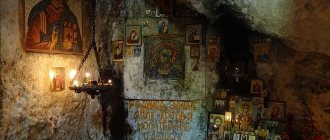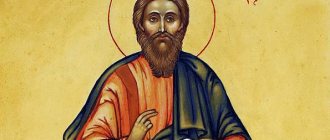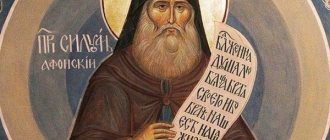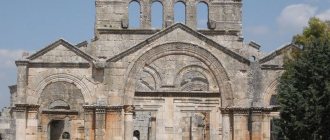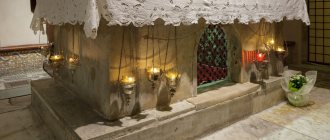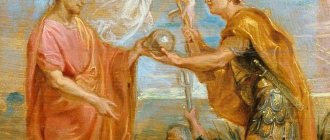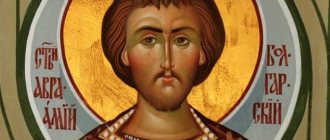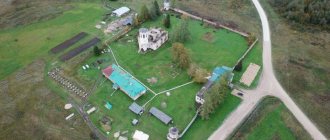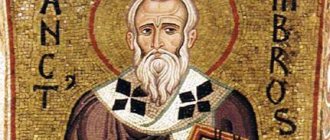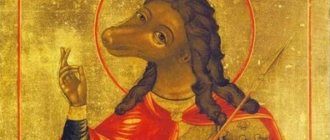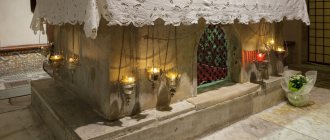This venerable saint was one of the 12 apostles who accepted the teachings of the Savior Jesus Christ. The life of the Apostle Simon the Zealot is examined from three different points of view. Middle Eastern chroniclers, Caucasian and English researchers wrote about his martyrdom.
The Holy Scriptures state that the apostle was the half-brother of the Son of God. Simon's nickname is translated from Aramaic into Russian as “zealot.” The Apostle Luke called him in his writings in Greek, Zealot, which means the same thing.
Biography of Simon the Canaanite
The Gospel is quite sparse in facts concerning the biography of Christ’s disciple. His name is mentioned only when all twelve apostles are listed. The rest of the information about the life of the saint can be gleaned from Tradition, which the churchmen officially recognized as true.
Very little is known about the life of Simon the Canaanite.
Youth years
Simon's father was Joseph the Betrothed, the said father of Jesus Christ. Thus, the Zealot is the half-brother of the Savior. For many years he did not recognize the relationship, upset by Joseph’s decision to equally divide the inheritance. However, later, having seen the first miracle of the Messiah, the future saint changed his attitude and became His disciple.
In Aramaic, Kananit means “zealot.” In the same interpretation, Luke also mentions the apostle, only in the Greek translation - Zealot. According to one version, this name was given to Simon according to the name of his hometown of Cana, which is next to Nazareth. However, most theologians prefer a different theory, according to which the Jews, who zealously fought against Roman rule, were called Zealots.
The Canaanite believed in Christ after the Messiah performed his first miracle - turning water into wine at Simon's wedding. This incident is mentioned in the writings of John the Theologian. A passage from the Holy Gospel is read during the wedding ceremony, which served as a reason to honor Zealot as the patron saint of marriage. So, having believed in the Savior, Simon leaves his family and follows Jesus as His disciple.
Preaching activities
Zealot began preaching after the miraculous Resurrection of the Son of God. On the fiftieth day, he received the gift and, together with the other apostles, set off to wander to bring the teachings of Christ to people. Simon traveled to many countries: Egypt, Libya, Mauritania, Judea, Syria, Armenia, Spain, England. All this is attested in the Christian traditions of different peoples.
The Canaanite, Matthew and Andrew the First-Called preached on the Iveron land, and then went to Ossetia. Next they visited Abkhazia, where the final point of their stay was the city of Sevast. Here the apostles separated, each going their own way. Simon remained, making himself a cell from a small grotto near the Psyrtskhi River. This happened two decades after the Ascension of Jesus.
How long the saint was engaged in his preaching activities in Abkhazia is unknown. However, during his entire stay, he converted many pagans to the Christian faith. Thanks to Zealot, the local residents abolished the bloody custom of human sacrifice.
The Canaanite was the first to introduce the rite of baptism among the ancient Abkhazians, thereby giving birth to the Christian faith among them.
Kananite healed any disease with one touch
Persecution and martyrdom
However, not all pagans agreed with the teachings of the Zealot. Due to the contradictions that arose, Simon was often persecuted and in the end was forced to accept martyrdom. There is no single theory of how this happened. Some theologians say that the execution took place in the British Isles during his journey in order to convert local residents to the Christian faith. Others support the view that the Canaanite was crucified along with Judas Thaddeus. However, most priests share the opinion that he was executed by the Georgian king Aderkiy. How the saint was deprived of his life also remains a mystery. According to some legends, he was crucified on a cross, others talk about beheading with a sword or dismemberment with a saw.
Simon the Canaanite had a nickname either because of his place of birth or because of his worldview
The only thing that remains for researchers is to pay attention to the nickname of St. Simon. It differs in different books of the New Testament:
- according to Mark and Matthew - Aramaic “Kananit”;
- according to Luke (Gospel + Acts) - Greek “Zealot”.
Luke most likely did not meet Saint Simon before writing his texts. Perhaps they did not see each other later. But if there is no doubt that the Gospel of Matthew was actually written by the one to whom it is attributed, then we are dealing with first-hand information - from a disciple of Jesus Christ.
Matthew knew Simon and communicated with him in a group of like-minded people.
And since he says that the apostle's name was Canaanite, we can rely on this. Luke's version is a translation, since both words mean the same thing: “fanatic”, “zealot”.
Among the Jews there really was a group of Zealots (this is more accurate than the synodal rendering of “Zealots”, and in Hebrew “Kanaim”) - a social movement against Greek influence. It is possible that even several of the apostles belonged to him. Perhaps this nickname was associated with the special religious zeal of St. Simon.
There is also an option that the apostle was simply born in Cana of Galilee, hence the nickname. It is not known exactly where she was. Tradition identifies it with the modern site of Kafr Qana.
New Athos Monastery, built where, as is commonly believed, the Apostle Simon the Canaanite lived in recent years. Photo: upload.tury.club
And here we must remember that one student actually came from Cana:
“After this Jesus appeared again to His disciples at the Sea of Tiberias. And so he appeared: Simon Peter, and Thomas, who is called the Twin, and Nathanael from Cana of Galilee, and the sons of Zebedee, and two others of His disciples were together.”
(John 21:2)
Could Nathanael be Simon? They are never mentioned together. Bible scholars note that there are many more parallels between Nathanael and Bartholomew, so they are probably the same person.
Who knows, maybe Bartholomew and Simon simply lived in the same area, or the guess about Simon’s origin from Cana is completely wrong.
The miraculous acts of the apostle
Living in Abkhazia, Simon became famous for his miracles - with one touch he healed any disease. The apostle laid his hands on the sore spot, sprinkled it with water, read a prayer in an incomprehensible dialect, and the man recovered. Observing miraculous healings, local residents gradually began to gain confidence in Christian teaching, and soon began to abandon paganism, accepting a new faith. Even after the death of the saint, believers continue to come to his grave to receive help, be healed and ask for salvation.
There is also Simeon, the brother of the Lord, an apostle from 70, perhaps this is the same person
The apostle named Simeon, the brother of the Lord, is not known to the Holy Scriptures. Perhaps the fact is that this is not some other person, but the same Simon the Zealot. We do not know. The authors of early Christianity tell us about the Apostle Simeon from 70. He could have been Jacob's cousin, which is why he received this nickname.
Not everything is transparent with this person’s biography either. There are different accounts of his life and different people who are identified with him. According to one version, Simeon sagged for 120 years, nailed to the cross.
Simeon the New Theologian
Days of remembrance and veneration of the saint
They pray twice in honor of the memory of Simon the Canaanite:
- May 23, as the patron saint of fertility;
- July 13, the day of the Council of all twelve apostles.
Working during Spring Memorial Day is not recommended. Tradition involves rest, protection from worries and hard work. At the end of the celebration, all planned work can begin with renewed vigor.
You can honor the memory of the saint on May 23 and July 13
Prayers
| Crucifixion of the Apostle Simon. (Minologii). Fresco of the Church of the Annunciation. Gračanica. Kosovo. Serbia. OK. 1318 |
Troparion, tone 3
, from the Greek Menaion, translation by Natalia Bakhareva [6]
Divine zeal/ by you in the flesh of the Known One, having shown you a zealot in the apostles./ And being jealous of the Master of death,/ You came forth to Him by the Cross./ Glorious to Simon,/ Christ God prayed ́// grant us great mercy
.
Kontakion, tone 2
The wisdom of the wisdom of learning in the soul of blessing hollow/ in praise is pleasing, as if the God -headed Vsi Simon:/ The throne of Bobs now is predestinated and with the delicious fun is fun, // Movy is constantly about all of us.
Abkhazian monastery in honor of the Apostle Simon
The temple was first erected in the 9th century on the site where the great martyr was buried. Gradually, Christianity took root among the Abkhaz people, cities began to appear, and with them churches and castles. However, a century later, the invading Turks changed the Christian faith to Muslim, and the monastery was almost completely destroyed.
The ancient temple was restored only six centuries later, when Emperor Alexander III transferred this territory to the inhabitants of the neighboring church - monks from Old Athos (Greece). Since then, the monastery has become a religious educational center of the Russian Empire. On its territory the Panteleimon Cathedral was erected, factories, a power plant, and a train station were built. Vineyards were planted in the fields and potatoes and other crops began to be grown.
The musical chimes, which are located on the highest bell tower of the monastery, were donated by Emperor Alexander III after the restoration of the temple.
The grotto where Zealot lived has not undergone any changes. Its interior remained the same, only instead of a rope, a convenient entrance with stone steps was made. The walls of the ancient cave are lined with mosaics, on which you can see the faces of the apostle himself, Jesus Christ and the Blessed Virgin Mary. Not far from the saint’s cell there is a healing spring, and next to it is a stone with impressions of Simon’s feet.
In 2011, the monastery was taken over by schismatics, and access for Russian pilgrims was limited. Despite this, you can get to the service in honor of the great martyr in other places:
- Sochi, Loo village, Temple of the Apostle Canaanite;
- Israel, Cana, Church of the Wedding;
- Tbilisi, Sameba Lavra;
- Sukhumi, Roman Catholic Church of St. Simon.
New Athos Monastery of St. Simon the Canaanite
Roman Catholic Church of St. Simon in Sukhumi
Sameba Lavra in Tbilisi
Service and prayer to the Apostle Simon the Canaanite
Prayer to Zealot helps to find marital happiness and create a strong family. It protects against quarrels with loved ones, helps to find peace and understanding between spouses. Sincere appeal to Simon relieves illnesses and also strengthens the spirit.
During the prayer reading, an akathist, a troparion, and also the prayer itself to the saint are said. The latter is also read during the wedding ceremony, blessing the newlyweds for marriage. The analogy with wine used in the text indicates the conversion of a sinful soul to piety.
Holy glorious and all-praised Apostle of Christ Simon, who was deemed worthy to receive into your home in Cana of Galilee our Lord Jesus Christ and His Most Pure Mother, our Lady Theotokos, and to be an eyewitness to the glorious miracle of Christ, revealed on your brother, turning water into wine! We pray to you with faith and love: beg Christ the Lord to transform our souls from sin-loving to God-loving; save and protect us with your prayers from the temptations of the devil and the falls of sin and ask us from above for help during our despondency and helplessness, so that we may not stumble over the stone of temptation, but steadily walk the saving path of the commandments of Christ, until we reach the abodes of paradise, where you now reside and rejoice . Hey, Apostle Spasov! Do not disgrace us, who firmly trust in you, but be our helper and protector in all our lives and help us end this temporary life in a pious and godly manner, receive a good and peaceful Christian death and be honored with a good answer at the Last Judgment of Christ, so that we escape the ordeals of the air and the power of the fierce ruler of the world, we will inherit the Kingdom of Heaven and glorify the magnificent Name of the Father and the Son and the Holy Spirit forever and ever. Amen.
Despite the scarce mention among the texts of Holy Scripture, Simon the Canaanite left behind an immeasurable mark on the history of the formation of Christianity. The Apostle managed to convert the most ossified pagans to the true faith, rooting the teachings of Christ in many countries of the world.
If you find an error, please select a piece of text and press Ctrl+Enter.
